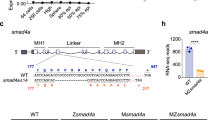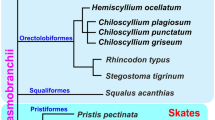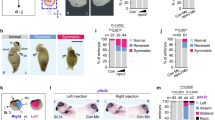Abstract
The Bone morphogenetic protein (Bmp) signalling gradient has a major function in the formation of the dorso-ventral axis. The zebrafish ventralized mutant, ogon, encodes Secreted Frizzled (Sizzled). sizzled is ventrally expressed in a Bmp-dependent manner and is required for the suppression of Bmp signalling on the ventral side of zebrafish embryos. However, it remains unclear how Sizzled inhibits Bmp signalling and controls ventro-lateral cell fate. We found that Sizzled stabilizes Chordin, a Bmp antagonist, by binding and inhibiting the Tolloid-family metalloproteinase, Bmp1a, which cleaves and inactivates Chordin. The cysteine-rich domain of Sizzled is required for inhibition of Bmp1a activity. Loss of both Bmp1a and Tolloid-like1 (Tll1; another Tolloid-family metalloproteinase) function leads to a complete suppression and reversal of the ogon mutant phenotype. These results indicate that Sizzled represses the activities of Tolloid-family proteins, thereby creating the Chordin–Bmp activity gradient along the dorso-ventral axis. Here, we describe a previously unrecognized role for a secreted Frizzled-related protein.
This is a preview of subscription content, access via your institution
Access options
Subscribe to this journal
Receive 12 print issues and online access
$209.00 per year
only $17.42 per issue
Buy this article
- Purchase on Springer Link
- Instant access to full article PDF
Prices may be subject to local taxes which are calculated during checkout





Similar content being viewed by others
References
Schier, A. F. & Talbot, W. S. Molecular genetics of axis formation in zebrafish. Annu. Rev. Genet. 39, 561–613 (2005).
Hibi, M., Hirano, T. & Dawid, I. B. Organizer formation and function. Results Probl. Cell Differ. 40, 48–71 (2002).
De Robertis, E. M. & Kuroda, H. Dorsal–ventral patterning and neural induction in Xenopus embryos. Annu. Rev. Cell Dev. Biol. 20, 285–308 (2004).
Sasai, Y. et al. Xenopus chordin: a novel dorsalizing factor activated by organizer-specific homeobox genes. Cell 79, 779–790 (1994).
Smith, W. C. & Harland, R. M. Expression cloning of noggin, a new dorsalizing factor localized to the Spemann organizer in Xenopus embryos. Cell 70, 829–840 (1992).
Piccolo, S., Sasai, Y., Lu, B. & De Robertis, E. M. Dorsoventral patterning in Xenopus: inhibition of ventral signals by direct binding of chordin to BMP-4. Cell 86, 589–598 (1996).
Zimmerman, L. B., De Jesus-Escobar, J. M. & Harland, R. M. The Spemann organizer signal noggin binds and inactivates bone morphogenetic protein 4. Cell 86, 599–606 (1996).
Larrain, J. et al. Proteolytic cleavage of chordin as a switch for the dual activities of twisted gastrulation in BMP signaling. Development 128, 4439–4447 (2001).
Piccolo, S. et al. Cleavage of chordin by xolloid metalloprotease suggests a role for proteolytic processing in the regulation of Spemann organizer activity. Cell 91, 407–416 (1997).
Marques, G. et al. Production of a DPP activity gradient in the early Drosophila embryo through the opposing actions of the SOG and TLD proteins. Cell 91, 417–426 (1997).
Blader, P., Rastegar, S., Fischer, N. & Strahle, U. Cleavage of the BMP-4 antagonist chordin by zebrafish tolloid. Science 278, 1937–1940 (1997).
Hammerschmidt, M., Serbedzija, G. N. & McMahon, A. P. Genetic analysis of dorsoventral pattern formation in the zebrafish: requirement of a BMP-like ventralizing activity and its dorsal repressor. Genes Dev. 10, 2452–2461 (1996).
Mullins, M. C. et al. Genes establishing dorsoventral pattern formation in the zebrafish embryo: the ventral specifying genes. Development 123, 81–93 (1996).
Solnica-Krezel, L. et al. Mutations affecting cell fates and cellular rearrangements during gastrulation in zebrafish. Development 123, 67–80 (1996).
Kishimoto, Y. et al. The molecular nature of zebrafish swirl: BMP2 function is essential during early dorsoventral patterning. Development 124, 4457–4466 (1997).
Schmid, B. et al. Equivalent genetic roles for bmp7/snailhouse and bmp2b/swirl in dorsoventral pattern formation. Development 127, 957–967 (2000).
Dick, A. et al. Essential role of Bmp7 (snailhouse) and its prodomain in dorsoventral patterning of the zebrafish embryo. Development 127, 343–354 (2000).
Bauer, H. et al. The type I serine/threonine kinase receptor Alk8/Lost-a-fin is required for Bmp2b/7 signal transduction during dorsoventral patterning of the zebrafish embryo. Development 128, 849–858 (2001).
Mintzer, K. A. et al. Lost-a-fin encodes a type I BMP receptor, Alk8, acting maternally and zygotically in dorsoventral pattern formation. Development 128, 859–869 (2001).
Hild, M. et al. The smad5 mutation somitabun blocks Bmp2b signaling during early dorsoventral patterning of the zebrafish embryo. Development 126, 2149–2159 (1999).
Kramer, C. et al. Maternally supplied smad5 is required for ventral specification in zebrafish embryos prior to zygotic bmp signaling. Dev. Biol. 250, 263–279 (2002).
Connors, S. A., Trout, J., Ekker, M. & Mullins, M. C. The role of tolloid/mini fin in dorsoventral pattern formation of the zebrafish embryo. Development 126, 3119–3130 (1999).
Hammerschmidt, M. et al. dino and mercedes, two genes regulating dorsal development in the zebrafish embryo. Development 123, 95–102 (1996).
Yabe, T. et al. Ogon/Secreted Frizzled functions as a negative feedback regulator of Bmp signaling. Development 130, 2705–2716 (2003).
Martyn, U. & Schulte-Merker, S. The ventralized ogon mutant phenotype is caused by a mutation in the zebrafish homologue of Sizzled, a secreted Frizzled-related protein. Dev. Biol. 260, 58–67 (2003).
Salic, A. N., Kroll, K. L., Evans, L. M. & Kirschner, M. W. Sizzled: a secreted Xwnt8 antagonist expressed in the ventral marginal zone of Xenopus embryos. Development 124, 4739–4748 (1997).
Bradley, L. et al. Different activities of the frizzled-related proteins frzb2 and sizzled2 during Xenopus anteroposterior patterning. Dev. Biol. 227, 118–132 (2000).
Collavin, L. & Kirschner, M. W. The secreted Frizzled-related protein Sizzled functions as a negative feedback regulator of extreme ventral mesoderm. Development 130, 805–816 (2003).
Nikaido, M. et al. Tbx24, encoding a T-box protein, is mutated in the zebrafish somite- segmentation mutant fused somites. Nature Genet. 31, 195–199 (2002).
Xie, J. & Fisher, S. Twisted gastrulation enhances BMP signaling through chordin dependent and independent mechanisms. Development 132, 383–391 (2005).
Lekven, A. C., Thorpe, C. J., Waxman, J. S. & Moon, R. T. Zebrafish wnt8 encodes two wnt8 proteins on a bicistronic transcript and is required for mesoderm and neurectoderm patterning. Dev. Cell 1, 103–114 (2001).
Lele, Z., Bakkers, J. & Hammerschmidt, M. Morpholino phenocopies of the swirl, snailhouse, somitabun, minifin, silberblick, and pipetail mutations. Genesis 30, 190–194 (2001).
Uren, A. et al. Secreted frizzled-related protein-1 binds directly to wingless and is a biphasic modulator of Wnt signaling. J. Biol. Chem. 275, 4374–4382 (2000).
Lin, K. et al. The cysteine-rich frizzled domain of Frzb-1 is required and sufficient for modulation of Wnt signaling. Proc. Natl Acad. Sci. USA 94, 11196–11200 (1997).
Jones, S. E. & Jomary, C. Secreted Frizzled-related proteins: searching for relationships and patterns. Bioessays 24, 811–820 (2002).
Kawano, Y. & Kypta, R. Secreted antagonists of the Wnt signalling pathway. J. Cell Sci. 116, 2627–2634 (2003).
Banyai, L. & Patthy, L. The NTR module: domains of netrins, secreted frizzled related proteins, and type I procollagen C-proteinase enhancer protein are homologous with tissue inhibitors of metalloproteases. Protein Sci. 8, 1636–1642 (1999).
Oelgeschlager, M., Kuroda, H., Reversade, B. & De Robertis, E. M. Chordin is required for the Spemann organizer transplantation phenomenon in Xenopus embryos. Dev. Cell 4, 219–230 (2003).
Schulte-Merker, S., Lee, K. J., McMahon, A. P. & Hammerschmidt, M. The zebrafish organizer requires chordino. Nature 387, 862–863 (1997).
Shimizu, T. et al. Cooperative roles of Bozozok/Dharma and Nodal-related proteins in the formation of the dorsal organizer in zebrafish. Mech. Dev. 91, 293–303 (2000).
Jones, C. M. & Smith, J. C. Establishment of a BMP-4 morphogen gradient by long-range inhibition. Dev. Biol. 194, 12–17 (1998).
Miller-Bertoglio, V. E. et al. Differential regulation of chordin expression domains in mutant zebrafish. Dev. Biol. 192, 537–550 (1997).
Furthauer, M., Thisse, B. & Thisse, C. Three different noggin genes antagonize the activity of bone morphogenetic proteins in the zebrafish embryo. Dev. Biol. 214, 181–196 (1999).
Nikaido, M. et al. In vivo analysis using variants of zebrafish BMPR-IA: range of action and involvement of BMP in ectoderm patterning. Development 126, 181–190 (1999).
Hashimoto, H. et al. The Cerberus/Dan-family protein Charon is a negative regulator of Nodal signaling during left-right patterning in zebrafish. Development 131, 1741–1753 (2004).
Nasevicius, A. & Ekker, S. C. Effective targeted gene 'knockdown' in zebrafish. Nature Genet. 26, 216–220 (2000).
Acknowledgements
We would like to thank N. Ueno, B. Thisse, C. Thisse, M. Halpern, K. Araki, U. Strähle, and S. Fisher for providing the DNA samples; A. Yamamoto, G. Sheng, and Y. Sasai for comments on the manuscript; M. Royle for editing the manuscript; H. Akiyama, K. Bando and Y. Wataoka for fish care and technical assistance; and all members of our laboratory for valuable discussion.
Author information
Authors and Affiliations
Corresponding author
Ethics declarations
Competing interests
The authors declare no competing financial interests.
Supplementary information
Supplementary Information
Supplementary Figures S1, S2, S3 and S4 (PDF 1584 kb)
Rights and permissions
About this article
Cite this article
Muraoka, O., Shimizu, T., Yabe, T. et al. Sizzled controls dorso-ventral polarity by repressing cleavage of the Chordin protein. Nat Cell Biol 8, 329–340 (2006). https://doi.org/10.1038/ncb1379
Received:
Accepted:
Published:
Issue Date:
DOI: https://doi.org/10.1038/ncb1379
This article is cited by
-
Pleiotropic functions of chordin gene causing drastic morphological changes in ornamental goldfish
Scientific Reports (2022)
-
Matricellular proteins in cancer: a focus on secreted Frizzled-related proteins
Journal of Cell Communication and Signaling (2018)
-
Osteogenesis induced by frizzled-related protein (FRZB) is linked to the netrin-like domain
Laboratory Investigation (2016)
-
SFRPs act as negative modulators of ADAM10 to regulate retinal neurogenesis
Nature Neuroscience (2011)
-
Complex and dynamic patterns of Wnt pathway gene expression in the developing chick forebrain
Neural Development (2009)



